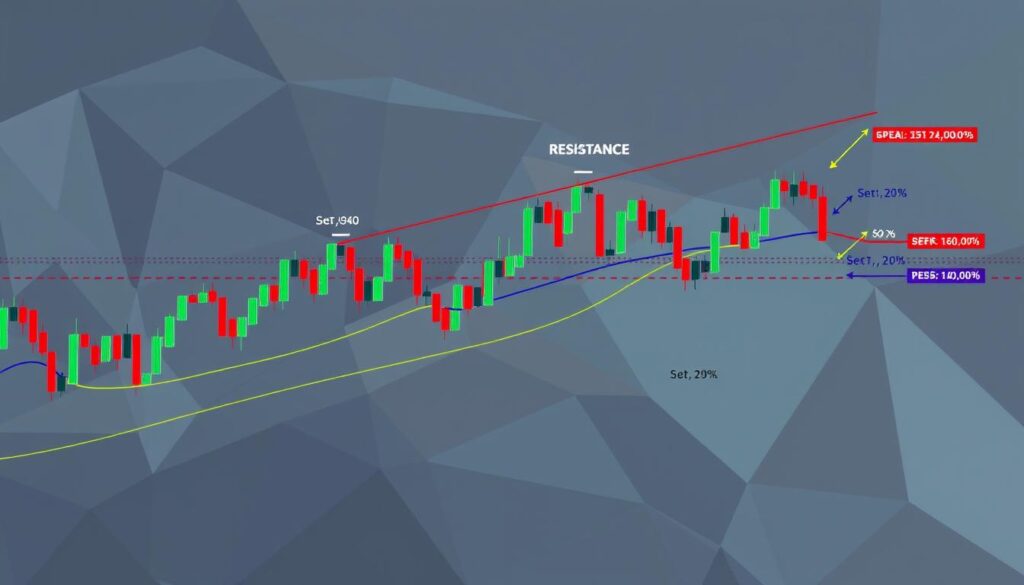Trading cryptocurrency can be a complex and volatile endeavor, but using support and resistance levels can help navigate the market. Support and resistance are fundamental concepts in crypto trading, assisting in predicting future price movements. These levels are crucial in technical analysis, as they indicate areas where the price of a cryptocurrency is likely to bounce back or break through, providing valuable insights for traders. By understanding support and resistance, traders can make informed decisions and develop effective strategies for crypto trading.
Support levels indicate strong buying interest, leading to price increases, offering prime buying opportunities. Resistance levels, on the other hand, show selling pressure surpassing buying pressure, resulting in price declines, indicating selling opportunities. Traders utilize historical price data, trend lines, and technical indicators to pinpoint support and resistance levels accurately, making it a powerful method for profitable and low-risk trading.
Table of Contents
Key Takeaways
- Support and resistance levels are essential concepts in crypto trading, helping predict future price movements.
- Support levels indicate strong buying interest, while resistance levels show selling pressure surpassing buying pressure.
- Technical analysis, including historical price data and trend lines, is used to identify support and resistance levels.
- Accurate identification of support and resistance levels is crucial for making informed trading decisions.
- Support and resistance trading is a powerful method for navigating the complex and volatile world of cryptocurrency trading.
- Automated tools are available to assist in identifying support and resistance levels in crypto trading, making it more accessible to traders.
- Crypto trading using support and resistance levels can be an effective strategy for profitable and low-risk trading.
Understanding Support and Resistance in Cryptocurrency Markets
Support and resistance levels are crucial concepts in crypto market dynamics, as they help traders understand price action and make informed decisions. In the context of trading psychology, these levels can significantly influence market behavior and trends. A support level is like a safety net for cryptocurrency prices, where the price tends to stop falling and might even bounce back up. On the other hand, resistance acts like a ceiling for cryptocurrency prices, where the price often struggles to break through and tends to pull back.
Historical price data can help identify strong support and resistance zones in cryptocurrency trading. For instance, round numbers like $10K or $20K often act as significant support and resistance levels in the cryptocurrency market. Drawing trend lines on a price chart can also be highly effective, where an upward-sloping trend line can act as support, while a downward-sloping trend line can serve as resistance. By understanding these concepts and applying them to crypto market dynamics, traders can develop a stronger trading plan and improve their chances of success.
Some key points to consider when working with support and resistance levels include:
- Monitoring support and resistance levels over various timeframes to identify long-term trends and potential reversals.
- Leveraging technical indicators like moving averages to identify dynamic support and resistance levels.
- Using high trading volume at support or resistance levels to validate their significance and increase the likelihood of price reactions.
By mastering the concepts of support and resistance, traders can gain a deeper understanding of crypto market dynamics and improve their trading psychology, ultimately leading to more effective trading decisions and better outcomes in the volatile cryptocurrency market.
The Psychology Behind Support and Resistance
Market sentiment plays a significant role in shaping support and resistance levels, as it reflects the collective trader behavior and expectations of market participants. The interaction between buyers and sellers determines the price patterns, and understanding these dynamics is crucial for making informed trading decisions. Support and resistance levels are often established by behavioral factors, such as anchoring bias and herd mentality, which can influence price patterns and ultimately affect the cryptocurrency’s price.
A key concept in technical analysis is that when a support or resistance level is breached, its role reverses. This means that a broken support level can become a resistance level, and vice versa. Market sentiment and trader behavior are essential in determining the strength of these levels, as they are often tested multiple times before being broken. The more times a level is tested without breaking, the stronger that area becomes, and the more significant the shift in market sentiment will be when it is eventually broken.
Some key statistics highlight the importance of support and resistance levels in technical analysis. For example, over 70% of traders place significant buy or sell orders around round numbers, such as $50,000 or $100,000 in cryptocurrency trading. These price patterns can lead to swift and pronounced market reactions, with trading volumes spiking as prices approach these levels. Understanding these psychological levels and how they influence trader behavior and market sentiment is essential for making informed trading decisions and navigating the complex world of cryptocurrency trading.
Essential Tools for Identifying Support and Resistance Levels
To identify support and resistance levels, traders use various trading tools and techniques. One of the simplest methods is to look at historical price data and identify points where the price has consistently stopped, reversed, or paused. These historical levels often serve as strong support and resistance zones.
Technical analysis platforms provide a range of chart analysis tools, including trend lines, moving averages, and volume analysis. These tools help traders visualize and confirm support and resistance levels. For example, drawing trend lines on a price chart can be highly effective in identifying areas of support and resistance.
Some key technical indicators used in identifying support and resistance levels include Fibonacci ratios, moving averages, and relative strength index (RSI). These indicators help traders identify potential reversal levels and predict future price movements. By combining these tools and techniques, traders can develop a comprehensive approach to identifying support and resistance levels and making informed trading decisions.
Key Considerations for Identifying Support and Resistance Levels
- Historical price data
- Trend lines and chart patterns
- Technical indicators, such as Fibonacci ratios and moving averages
- Volume analysis and market liquidity
By considering these factors and using the right trading tools, traders can improve their ability to identify support and resistance levels and make more accurate predictions about future price movements.
Common Mistakes When Trading Support and Resistance
When it comes to trading support and resistance levels, trading errors can be costly. One common mistake is assuming that these levels are invincible, which can lead to significant losses if they break. Effective risk management is crucial in mitigating these losses.
A thorough market analysis is essential in identifying support and resistance levels. This includes considering various factors such as trendlines, moving averages, and psychological round numbers. By combining these levels with other technical indicators, traders can make more informed decisions.
Some common mistakes to avoid include:
- Misidentifying support and resistance levels
- Ignoring broader market conditions
- Over-relying on these levels without considering other factors
- Failing to adapt to changing market dynamics
By being aware of these common mistakes, traders can refine their strategies and develop a more nuanced approach to using support and resistance in their trading decisions. Remember, risk management and continuous market analysis are key to successful trading.
| Mistake | Consequence |
|---|---|
| Misidentifying levels | Incorrect trading decisions |
| Ignoring market conditions | Failure to adapt to changes |
| Over-relying on levels | Insufficient consideration of other factors |
How to Trade Crypto Using Support and Resistance Levels: Step-by-Step Guide
Trading cryptocurrency using support and resistance levels requires a well-thought-out trading strategy. This involves identifying key levels, selecting optimal entry points, setting stop losses, and taking profits. Effective risk management is crucial in this process, as it helps mitigate potential losses and maximize profit targets.
A key aspect of this strategy is understanding how to identify support and resistance zones. This can be done by analyzing historical price data, psychological price levels, and high trading volumes. Breaching critical support or resistance levels can significantly influence market trends, making it essential to wait for price confirmation before trading.
Some common techniques for identifying support and resistance levels include using trendlines, moving averages, and Fibonacci levels. It’s also important to consider multiple time frames and volume analysis to validate the significance of these levels. By combining these techniques with a solid trading strategy and risk management plan, traders can increase their chances of success in the crypto market.
To further enhance their trading strategy, traders can use tools like TradingView, which offers advanced features for support and resistance analysis. This can help traders predict market moves more accurately and make informed decisions. By following a step-by-step guide and staying disciplined, traders can develop a profitable trading strategy that incorporates support and resistance levels.
| Technique | Description |
|---|---|
| Trendlines | Used to identify support and resistance levels by connecting price zones |
| Moving Averages | Used to identify support and resistance levels by analyzing historical price data |
| Fibonacci Levels | Used to identify support and resistance levels by analyzing price retracements |
Dynamic vs Static Support and Resistance Levels
In the context of cryptocurrency trading, understanding the difference between dynamic and static support and resistance levels is crucial. Static levels are based on historical price points, whereas dynamic levels adapt to changing market conditions, influenced by price trends and market volatility. This adaptability makes dynamic levels particularly useful in volatile markets where traditional fixed levels might quickly become obsolete.
Traders utilize various dynamic indicators such as trend lines, volatility bands, and moving averages to identify support and resistance levels. These indicators provide real-time insights into price trends, allowing for adaptive trading strategies. For instance, moving averages can act as dynamic support or resistance, offering a more fluid representation of market sentiment.
A key advantage of dynamic levels is their ability to adjust to market volatility, making them more reliable in unpredictable market conditions. However, they can be more complex to interpret than static levels, requiring a deeper understanding of price trends and market dynamics. By combining dynamic support and resistance levels with adaptive trading strategies, traders can better navigate the complexities of cryptocurrency markets.
Ultimately, the choice between dynamic and static support and resistance levels depends on the trader’s strategy and the current market conditions. By understanding the strengths and weaknesses of each approach, traders can make more informed decisions and develop a more effective trading plan.
| Indicator | Description |
|---|---|
| Trend Lines | Used to identify trends and potential support or resistance levels |
| Volatility Bands | Indicate market volatility and potential breakouts |
| Moving Averages | Provide dynamic support or resistance levels based on historical price data |
Combining Support and Resistance with Other Technical Indicators
Technical analysis is a crucial aspect of trading, and combining support and resistance levels with other technical indicators can enhance the effectiveness of a trading strategy. By using indicator combinations, traders can gain a more comprehensive view of market conditions and make more informed decisions. For example, combining moving averages with the Relative Strength Index (RSI) can help identify overbought or oversold conditions near support and resistance levels.
One of the key benefits of combining support and resistance with other technical indicators is that it can help traders identify trading signals more accurately. By using a combination of indicators, such as moving averages, RSI, and volume analysis, traders can confirm the strength of identified levels and make more confident trading decisions. Technical analysis platforms can provide traders with a wide range of indicators to choose from, making it easier to find the right combination for their trading strategy.
Moving Averages
Moving averages are a popular technical indicator used to identify trends and potential reversals in the market. By combining moving averages with support and resistance levels, traders can gain a better understanding of market dynamics and make more informed trading decisions.
RSI and MACD
The Relative Strength Index (RSI) and Moving Average Convergence Divergence (MACD) are two momentum indicators that can be used to confirm or contradict signals from support and resistance levels. By combining these indicators with moving averages and volume analysis, traders can gain a more comprehensive view of market conditions and make more accurate trading decisions.
| Indicator | Description |
|---|---|
| Moving Averages | Identify trends and potential reversals |
| RSI | Confirm or contradict signals from support and resistance levels |
| MACD | Identify bullish or bearish trends and momentum |
| Volume Analysis | Confirm the strength of identified levels |
Risk Management Strategies for Support and Resistance Trading
Effective risk assessment is crucial when trading crypto using support and resistance levels. This involves evaluating the potential risks and rewards of a trade, considering factors such as market volatility and liquidity. To manage risk, traders can use position sizing strategies, which involve calculating the optimal amount of capital to allocate to a trade based on the trader’s risk tolerance and account balance.
A key component of risk management is stop-loss placement. Support and resistance levels can serve as valuable guides for setting stop-loss orders. For example, a trader can place a stop-loss just below a support level for a long position or just above a resistance level for a short position. This helps to limit potential losses if the trade does not move in the expected direction.
- Diversification across assets to reduce overall risk
- Using risk management tools, such as calculators and portfolio trackers
- Implementing strategic position sizing and stop-loss placement
By incorporating these strategies into their trading plan, traders can better manage risk and increase their chances of success in the crypto market.
Advanced Support and Resistance Trading Patterns
Advanced traders often look for specific chart patterns that can indicate potential trend reversals or breakout trading opportunities. These patterns can form around support and resistance levels, providing valuable insights into market sentiment and potential price movements.
Some common advanced patterns include double tops and bottoms, triple tops and bottoms, and head and shoulders patterns. These patterns can be particularly useful in identifying potential trend reversals, as they often indicate a shift in market sentiment.
By mastering these advanced chart patterns and understanding how they relate to support and resistance levels, traders can gain a competitive edge in the market. This knowledge can help traders anticipate potential breakout trading opportunities and make more informed decisions about their trades.
It’s also important to consider the role of volume in confirming these patterns, as well as the potential for trend reversals to occur at key support and resistance levels. By combining these factors, traders can develop a more comprehensive understanding of the market and make more effective trading decisions.
Real-World Examples of Successful Crypto Trades
Successful crypto trades often rely on careful trading analysis and an understanding of market trends. By examining case studies of profitable trades, traders can gain valuable insights into the decision-making process and strategies used by experienced traders.
A notable example is the trade of Bitcoin in April 2020, where the price rose to $10K, a key resistance level, before reversing downward. This type of trade highlights the importance of identifying and utilizing support and resistance levels in crypto trading.
Some common strategies used in successful crypto trades include:
- Swing trading, which involves holding cryptocurrencies for short periods to capitalize on short-term price movements
- Scalping trading, which focuses on making quick profits by trading cryptocurrencies within a short time frame
- Position trading, which involves holding positions in cryptocurrencies for extended periods to benefit from long-term trends
By studying these case studies and understanding the trading analysis and market trends that led to their success, traders can develop their own effective trading strategies and improve their chances of making profitable trades.
| Trade Type | Time Frame | Profit/Loss |
|---|---|---|
| Swing Trade | 1 week | 10% |
| Scalping Trade | 1 hour | 5% |
| Position Trade | 1 month | 20% |
Market Volatility and Support/Resistance Reliability
Market conditions play a significant role in determining the reliability of support and resistance levels in cryptocurrency trading. Volatility analysis is crucial in understanding how market conditions impact these levels. In trading environments with high volatility, support and resistance levels can be less reliable due to rapid price movements.
These price movements can lead to false breakouts, making it challenging for traders to determine the validity of support and resistance levels. On the other hand, low volatility periods can make support and resistance levels more reliable, but these periods can also lead to sudden, explosive breakouts. To adapt to different volatility environments, traders can adjust their stop-loss distances and profit targets.
Tools like the Average True Range (ATR) indicator can help measure and predict volatility. By understanding the relationship between market volatility and support/resistance reliability, traders can adjust their strategies to current market conditions, potentially improving their trading outcomes. This involves analyzing market conditions, trading environments, and conducting thorough volatility analysis to make informed decisions.
- Adjusting stop-loss distances based on market volatility
- Setting profit targets according to support and resistance levels
- Using tools like the ATR indicator to measure and predict volatility
By taking these factors into account, traders can develop effective strategies for navigating different market conditions and improving their overall trading performance.
Building Your Own Support and Resistance Trading Strategy
To develop a successful trading strategy, it’s essential to take a personalized approach. This involves defining your trading objectives, risk tolerance, and selecting the right crypto assets and timeframes that align with your trading style. A well-structured strategy development process will help you create a tailored plan that suits your needs.
A crucial step in strategy development is backtesting. This involves using historical data to validate and refine your trading strategy. By analyzing how your strategy would have performed in the past, you can identify areas for improvement and increase your confidence in your approach.
When building your strategy, consider the following key elements:
- Define your trading objectives and risk tolerance
- Select the right crypto assets and timeframes
- Develop a set of trading rules based on support and resistance levels
- Use backtesting to validate and refine your strategy
By following these steps and taking a personalized approach to strategy development, you can create a successful trading strategy that helps you achieve your goals. Remember to continuously monitor and refine your strategy using backtesting and other tools to stay ahead in the crypto market.
Common Support and Resistance Trading Myths Debunked
Trading misconceptions can lead to significant losses in the cryptocurrency market. It’s essential to separate fact from fiction and understand the market realities that drive support and resistance levels. By applying critical thinking, traders can make more informed decisions and avoid common pitfalls.
One common myth is that support and resistance levels always hold. However, this is not the case. These levels are probabilistic tools, not guarantees. The concept that levels which previously acted as support will eventually become resistance is a fundamental technical analysis principle. Levels that formed resistance will act as support once the price breaks above the resistance level.
Human emotions such as fear, greed, and herd instinct play a significant role in market participant behavior and impact support and resistance levels. Emotional price levels like round numbers, 52-week highs and lows, and historic market events are significant due to human psychology and market participants’ behavioral responses to these levels. The following are key factors to consider when evaluating support and resistance levels:
- Market sentiment and emotional price levels
- Previous price points and anchoring
- Trend strength and trading volume
- Psychological and fundamental factors
By understanding these factors and avoiding trading misconceptions, traders can develop a more nuanced approach to support and resistance trading. This involves considering market realities, applying critical thinking, and continually refining their trading strategies to adapt to changing market conditions.
Ultimately, successful trading requires a deep understanding of the complex interactions between market participants, emotional price levels, and technical analysis principles. By debunking common myths and focusing on market realities, traders can make more informed decisions and achieve greater success in the cryptocurrency market.
| Support and Resistance Level | Characteristics | Trading Strategy |
|---|---|---|
| Strong Support | Multiple touches, high trading volume | Buy on pullback, set stop loss below support |
| Weak Resistance | Few touches, low trading volume | Sell on breakout, set stop loss above resistance |
| Emotional Price Level | Round number, 52-week high/low | Buy or sell on test of emotional price level |
Conclusion
As we conclude this comprehensive guide on trading cryptocurrencies using support and resistance levels, it’s clear that these technical analysis tools remain essential for trading skills and market adaptation. While no single indicator can guarantee 100% accuracy, mastering the nuances of support and resistance is crucial for continuous learning and developing a robust trading strategy.
The psychology behind these levels, the various methods for identifying them, and the strategies for effectively utilizing them have all been explored in-depth. Ultimately, the ability to recognize and respond to shifting market dynamics, as evidenced by support and resistance breakouts and bounces, is a hallmark of successful market adaptation in the volatile cryptocurrency space.
Remember, trading is an ongoing process of skill development and market awareness. By continually honing your techniques, exploring new indicators, and adapting your approach to changing market conditions, you’ll be well-positioned to navigate the ever-evolving crypto landscape and unlock your full potential as a trader.
FAQ
What are support and resistance levels in cryptocurrency markets?
Support and resistance levels are key price points where the market tends to find difficulty in breaking through. Support levels are prices at which demand is strong enough to prevent the price from falling further, while resistance levels are prices at which selling pressure is high enough to stop the price from rising.
Why are support and resistance levels crucial for cryptocurrency trading?
Support and resistance levels are crucial for cryptocurrency trading because they provide important insights into market sentiment, price movements, and potential trading opportunities. These levels can act as dynamic support or resistance, guiding traders on when to enter, exit, or manage their positions.
How do the psychological aspects of the market create support and resistance levels?
The psychological aspects of the market, such as anchoring bias, herd mentality, and the impact of round numbers, all contribute to the formation of support and resistance levels. These levels reflect market sentiment and expectations, providing traders with valuable insights into the emotional drivers behind price movements.
What tools and techniques can be used to identify support and resistance levels in cryptocurrency markets?
Traders can use a variety of technical analysis tools and techniques to identify support and resistance levels, including chart patterns, indicators like trend lines and moving averages, and volume analysis. Considering different time frames is also important when spotting these key levels.
What are some common mistakes traders make when using support and resistance levels in cryptocurrency trading?
Some common mistakes include over-relying on these levels without considering other factors, misinterpreting false breakouts, and failing to adapt to changing market conditions. Traders should also avoid using support and resistance levels in isolation, without incorporating other technical and fundamental analysis tools.
How can traders incorporate support and resistance levels into their cryptocurrency trading strategy?
Traders can incorporate support and resistance levels into their trading strategy by using them to identify optimal entry points, set stop-loss orders, and determine profit-taking levels. A step-by-step approach that emphasizes patience, discipline, and continuous learning is crucial for successful support and resistance-based trading.
What is the difference between dynamic and static support and resistance levels in cryptocurrency markets?
Static support and resistance levels are based on historical price points, while dynamic levels adapt to changing market conditions. Examples of dynamic levels include moving averages and trend lines. Understanding the advantages and disadvantages of each approach is important for traders to choose the most suitable method for their trading style and market conditions.
How can traders enhance their support and resistance analysis by combining it with other technical indicators?
Traders can enhance their support and resistance analysis by combining it with other technical indicators, such as moving averages, RSI, MACD, and volume analysis. These indicator combinations can provide additional confirmation or contradict signals from support and resistance levels, leading to a more robust and comprehensive trading strategy.
What are some advanced chart patterns that form around support and resistance levels in cryptocurrency markets?
Traders can look for advanced chart patterns that form around support and resistance levels, such as double tops and bottoms, triple tops and bottoms, and head and shoulders patterns. These patterns can signal potential trend reversals and breakouts, providing traders with high-probability trading opportunities.
How does market volatility impact the reliability and effectiveness of support and resistance levels in cryptocurrency trading?
Market volatility can significantly impact the reliability and effectiveness of support and resistance levels. High volatility periods can lead to false breakouts and quickly invalidate previously established levels, while low volatility periods can make these levels more reliable but also increase the risk of sudden, explosive breakouts. Traders need to adapt their strategies to different volatility environments.









